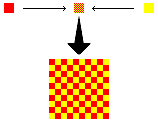
Have you ever been surfing along and noticed that some images look pretty crappy? Like all full of speckles? If so, then you have fallen victim to the CLUT. (Keep in mind this was written in 1996. Unless you're using a VERY old box, you probably haven't seen any "speckles". That said, read on.)
Now, before I go any further, let me warn you that I'm really not all that much of a computer geek, so I can only explain things as I understand them. That means I know what I'm talking about... most of the time. That said, let me try to tell you about the how's and why's of computer displays and colors... as I understand it.
* * *
Most computers can run in one of 3 (maybe more) color modes-
If you are in true color mode your computer is configured to display up to 16.7 million distinct colors. That gives you a couple million shades of red alone. It's kind of nice because feathered edges look feathered, photographs look fantastic and nice backgrounds actually look nice!
There is a price to pay however. Your poor computer has to work extra hard trying to display everything. Consequently things tend to work a little slower and often a little jerkier. But I gotta admit, images look very good.
If you want to give your processor a bit of a break, you can set your computer to display 64,000 colors rather than 16.7 million. This is the high color mode. Although there is a huge difference between 16.7 million and 64,000 to your computer, the difference is hardly noticeable to your average run-of-the-mill human. You get nice looking images, nicely feathered edges and there's not much in the way of jerkiness or slowness in your display.
Now if your like me, and super high image quality takes a back seat to speed, and you want your display to take up as little resources as possible, or if you have an older computer, you putz around in 256 color mode. All this means is your computer says "Listen, I know that there are 16.7 million colors. But what I'm going to do is only use 256 at a time. If I have to display an image that technically has 80,000 colors in it, I'm just going to try and find the closest 256 colors and just use them. Deal with it."
Now let's take that one step further. Let's suppose your computer is in 256 color mode and you're running Netscape. Netscape says, "I am taking over your colors. Since you only have 256 colors to play with, I am assigning a permanent value to 216 of them. The remaining 40 can be used any way you want." The end result is Netscape dithers all images to those 216 colors.
 |
Dithering is when your computer takes a couple colors it has and tries to blend them to make a color that it doesn't have. This "dithering" is why images are sometimes speckled. |
Why does it do this?? Let's suppose you have a web page with two pictures on it. One picture contains 150 distinct colors. The second picture contains another 150 distinct colors. If you display them together then all of a sudden your computer has to deal with 300 separate colors, not to mention the colors for your taskbar and buttons, etc. This throws a serious monkeywrench into the 256 color idea. So what Netscape does is say "Here are the 216 colors we will use for ALL images. Everything gets dithered to these colors."
Netscape's 216 colors
This group of colors is called a CLUT. As far as I know, all browsers have one. However, I don't know if all browsers use the same colors in their clut, or how colors and cluts and such work on operating systems other than Windows. (Hey, I warned you that I didn't know everything)
| About Netscape's Colors (part 2) >> |
| Upload Your Pages Color Chart Practice Exercises Color Picker |
| Index & Quick Reference Barebones HTML Guide Table of Contents |
| Print version available PageTutor.com membership |
|
Selfonline-education FREE LINK SHOPPING FREE GIFT
|
|